Bridging the Gap between Theoretical Learning and Practical Application: A Qualitative Study in the Italian Educational Context
Abstract
1. Introduction
2. Background
2.1. Overview of School to Work Alternation (SWA)
2.2. Theoretical Framework: Employability and Sense of Agency
2.3. Empowering Employability and Sense of Agency through School-Work Alternance
3. Aim and Objectives
- Examine lived experiences, through an in-depth exploration of the experiences of high school students engaged in SWA, to understand the intricacies of their interactions with both working and educational settings.
- Evaluate impact on perception of employability and sense of agency: we want to investigate how SWA influences student’s perceptions of employability by analyzing the skills, attitudes, and insights they acquire during their participation in the program, as well as students’ ability to exercise control over their learning and career path.
- Examine the impact of self-orientation, investigating the influence of SWA on student’s ability to actively navigate their career paths and their perception regarding the program’s utility to assist them in their future vocational choice.
- Contribute insights to educational discourse: this study aspires to contribute meaningful insights to the ongoing discourse surrounding the integration of practical experiences in contemporary education, providing recommendations for educators and policymakers to prepare students for the dynamic demands of the modern job market.
4. Materials and Methods
4.1. Data Collection
4.2. Mix Method Data Analysis
4.3. Participants and Procedures
5. Results
5.1. Quantitative Results
5.2. Qualitative Results
5.3. T-Lab Results
6. Discussion
Author Contributions
Funding
Institutional Review Board Statement
Informed Consent Statement
Data Availability Statement
Conflicts of Interest
References
- Svetsky, S.; Moravcik, O.; Tanuska, P.; Markechova, I. The practical experiences with educational software for modelling interactive collaborative teaching. In Teaching and Learning in a Digital World, Proceedings of the 20th International Conference on Interactive Collaborative Learning, Budapest, Hungary, 27–29 September 2017; Springer International Publishing: Berlin/Heidelberg, Germany, 2018; Volume 1, pp. 41–47. [Google Scholar]
- Hutter, R.I.; Oldenhof-Veldman, T.; Pijpers, J.R.; Oudejans, R.R. Professional development in sport psychology: Relating learning experiences to learning outcomes. J. Appl. Sport. Psychol. 2017, 29, 1–16. [Google Scholar] [CrossRef]
- Samaddar, R.; Sikdar, D.P. Comparison between Activity-Based Learning and Traditional Learning. Int. J. Educ. Res. 2023, 6, 17–27. [Google Scholar]
- Smeby, J.-C.; Heggen, K. Coherence and the development of professional knowledge and skills. J. Educ. Work 2014, 27, 71–91. [Google Scholar] [CrossRef]
- Hatlevik, I.K.R. The theory-practice relationship: Reflective skills and theoretical knowledge as key factors in bridging the gap between theory and practice in initial nursing education. J. Adv. Nurs. 2012, 68, 868–877. [Google Scholar] [CrossRef]
- Kurczewska, A.; Doryń, W.; Wawrzyniak, D. An everlasting battle between theoretical knowledge and practical skills? The joint impact of education and professional experience on entrepreneurial success. Entrep. Bus. Econ. Rev. 2020, 8, 219–237. [Google Scholar] [CrossRef]
- Giannini, M. How to improve the effectiveness of training: The school-work alternation projects. Turk. Online J. Educ. Technol. 2015, 264–269. [Google Scholar]
- Giovannella, C. Incubator of Projectuality: An Innovation-Based Approach to Mitigate Criticalities of the Massive Alternance Scheme Designed for the Italian School-Based Educational System. Int. J. Digit. Lit. Digit. Competence 2017, 8, 55–66. [Google Scholar] [CrossRef]
- Gremigni, E. Alternating School-Work Pathways in Italy. Some Remarks on the “Competence Society”. Partecip. Conflitto 2019, 12, 217–238. [Google Scholar]
- Brunetti, I.; Corsini, L. School-to-work transition and vocational education: A comparison across Europe. Int. J. Manpow. 2019, 40, 1411–1437. [Google Scholar] [CrossRef]
- Giovannella, C. An analysis of alternation schemes to increase student employability and the smartness of secondary schools. In Ludic, Co-design and Tools Supporting Smart Learning Ecosystems and Smart Education, Proceedings of the 5th International Conference on Smart Learning Ecosystems and Regional Development; Springer: Singapore, 2021; pp. 39–51. [Google Scholar]
- Trigwell, K.; Reid, A. Introduction: Work-based learning and the students’ perspective. High. Educ. Res. Dev. 1998, 17, 141–154. [Google Scholar] [CrossRef]
- Lester, S.; Costley, C. Work-based learning at higher education level: Value, practice and critique. Stud. High. Educ. 2010, 35, 561–575. [Google Scholar] [CrossRef]
- Sivarajah, R.T.; Curci, N.E.; Johnson, E.M.; Lam, D.L.; Lee, J.T.; Richardson, M.L. A review of innovative teaching methods. Acad. Radiol. 2019, 26, 101–113. [Google Scholar] [CrossRef]
- Kalyani, D.; Rajasekaran, K. Innovative teaching and learning. J. Appl. Adv. Res. 2018, 3, 23–25. [Google Scholar] [CrossRef]
- Camarda, R. Debate in Italian schools: State of the art of a (still) innovative teaching methodology. In Proceedings of the 17th International Technology, Education and Development Conference, Valencia, Spain, 6–8 March 2023; pp. 2201–2205. [Google Scholar]
- Tino, C.; Fedeli, M. The Key-Role of Teachers within the Italian School-Work Alternation Programs. Comm. Int. Adult Educ. 2016, 269–275. [Google Scholar]
- Morselli, D.; Marcelli, A. Entrepreneurship Competence in Vocational Education and Training: Case Study: Italy; CEDEFOP: Thessaloniki Region, Greece, 2022. [Google Scholar] [CrossRef]
- Darmanto, S.; Yuliari, G. Mediating role of entrepreneurial self efficacy in developing entrepreneurial behavior of entrepreneur students. Acad. Entrep. 2018, 24, 1–14. [Google Scholar]
- Albanesi, C.; Prati, G.; Guarino, A.; Cicognani, E. School citizenship education through YPAR: What works? A mixed-methods study in Italy. J. Adolesc. Res. 2021, 38, 143–177. [Google Scholar] [CrossRef]
- Georgara, A.; Kazhamiakin, R.; Mich, O.; Approsio, A.P.; Pazzaglia, J.-C.; Aguilar, J.A.R.; Sierra, C. The AI4Citizen pilot: Pipelining AI-based technologies to support school-work alternation programmes. Appl. Intell. 2023, 53, 1–30. [Google Scholar] [CrossRef]
- King, L.G.; McKim, A.J.; Raven, M.R.; Pauley, C.M. New and Emerging Technologies: Teacher Needs, Adoption, Methods, and Student Engagement. J. Agric. Educ. 2019, 60, 277–290. [Google Scholar] [CrossRef]
- Cardullo, V.M.; Wilson, N.S.; Zygouris-Coe, V.I. Enhanced student engagement through active learning and emerging technologies. In Student Engagement and Participation: Concepts, Methodologies, Tools, and Applications; IGI Global: Hershey, PA, USA, 2018; pp. 399–417. [Google Scholar]
- Fettes, T.; Evans, K.; Kashefpakdel, E. Putting skills to work: It’s not so much the what, or even the why, but how. J. Educ. Work 2020, 33, 184–196. [Google Scholar] [CrossRef]
- Gazier, B. Employability: Concepts and Policies; European Employment Observatory: Berlin, Germany, 1998. [Google Scholar]
- Forrier, A.; Sels, L. The concept employability, a complex mosaic. Int. J. Hum. Resour. 2003, 3, 102–104. [Google Scholar] [CrossRef]
- McQuaid, R.W.; Lindsay, C. The concept of employability. Urban Stud. 2005, 42, 197–219. [Google Scholar] [CrossRef]
- Bouncken, R.B.; Aslam, M.M.; Gantert, T.M.; Kallmuenzer, A. New work design for knowledge creation and sustainability: An empirical study of coworking-spaces. J. Bus. Res. 2023, 154, 113337. [Google Scholar] [CrossRef]
- Giffi, V.; Fantinelli, S.; Galanti, T. Adapting to Change: Investigating the Influence of Distance Learning on Performance in Italian Conservatories. Soc. Sci. 2023, 12, 664. [Google Scholar] [CrossRef]
- Chafi, M.B.; Hultberg, A.; Yams, N.B. Post-pandemic office work: Perceived challenges and opportunities for a sustainable work environment. Sustainability 2021, 14, 294. [Google Scholar] [CrossRef]
- Schmid, Y.; Dowling, M. New work: New motivation? A comprehensive literature review on the impact of workplace technologies. Manag. Rev. Q. 2020, 72, 59–86. [Google Scholar] [CrossRef]
- Fantinelli, S.; Di Fiore, T.; Marzuoli, A.; Galanti, T. Self-Perceived Employability of Workers With Disability: A Case Study in an Educational Farm. Front Psychol. 2022, 13, 871616. [Google Scholar] [CrossRef]
- Lodi, E.; Zammitti, A.; Magnano, P.; Patrizi, P.; Santisi, G. Italian adaption of self-perceived employability scale: Psychometric properties and relations with the career adaptability and well-being. Behav. Sci. 2020, 10, 82. [Google Scholar] [CrossRef]
- Gerçek, M. Serial multiple mediation of career adaptability and self-perceived employability in the relationship between career competencies and job search self-efficacy. High. Educ. Ski. Work.-Based Learn. ahead of preprint. 2023. [Google Scholar] [CrossRef]
- Nghia, T.L.H.; Pham, T.; Tomlinson, M.; Medica, K.; Thompson, C. Employability, employability capital, and career development: A literature review. In Developing and Utilizing Employability Capitals; Routledge: London, UK, 2020; pp. 41–65. [Google Scholar]
- Bridgstock, R.; Grant-Iramu, M.; Bilsland, C.; Tofa, M.; Lloyd, K.; Jackson, D. Going beyond “getting a job”: Graduates’ narratives and lived experiences of employability and their career development. In Education for Employability; Brill: Leiden, The Netherlands, 2019; Volume 2, pp. 89–104. [Google Scholar]
- McArdle, S.; Waters, L.; Briscoe, J.P.; Hall, D.T. Employability during unemployment: Adaptability, career identity and human and social capital. J. Vocat. Behav. 2007, 71, 247–264. [Google Scholar] [CrossRef]
- Smith, V. Enhancing employability: Human, cultural, and social capital in an era of turbulent unpredictability. Hum. Relat. 2010, 63, 279–300. [Google Scholar] [CrossRef]
- Peeters, E.; Nelissen, J.; De Cuyper, N.; Forrier, A.; Verbruggen, M.; De Witte, H. Employability capital: A conceptual framework tested through expert analysis. J. Career Dev. 2017, 46, 79–93. [Google Scholar] [CrossRef]
- Praskova, A.; Creed, P.A.; Hood, M. Career identity and the complex mediating relationships between career preparatory actions and career progress markers. J. Vocat. Behav. 2015, 87, 145–153. [Google Scholar] [CrossRef]
- Mao, J.; Shen, Y. Identity as career capital: Enhancing employability in the creative industries and beyond. Career Dev. Int. 2020, 25, 186–203. [Google Scholar] [CrossRef]
- Donald, W.E.; Baruch, Y.; Ashleigh, M. The undergraduate self-perception of employability: Human capital, careers advice, and career ownership. Stud. High. Educ. 2019, 44, 599–614. [Google Scholar] [CrossRef]
- Bandura, A. Toward a psychology of human agency. Perspect. Psychol. Sci. 2006, 1, 164–180. [Google Scholar] [CrossRef]
- McKelway, M. Women’s Agency and Women’s Employment: How Women’s Sense of Agency Affects Their Labor Supply; Stanford King Center on Global Development: Stanford, CA, USA, 2021. [Google Scholar]
- Nguyen, H.L. Individual stories of agency: An exploratory study into the pandemic impact on students’ employability skills. High. Educ. Ski. Work. Learn. 2023. [Google Scholar] [CrossRef]
- Tino, C.; Fedeli, M. Career planning, proactivity, self-employability, and labour market: Undergraduates’ perceptions. Form@Re—Open J. Per Form. Rete 2022, 22, 262–278. [Google Scholar] [CrossRef]
- Reeve, J.; Tseng, C.-M. Agency as a fourth aspect of students’ engagement during learning activities. Contemp. Educ. Psychol. 2011, 36, 257–267. [Google Scholar] [CrossRef]
- Davies, K. Nurturing Students’ Resilience and Agency. In Contemplative Approaches to Sustainability in Higher Education: Theory and Practice; Taylor & Francis: Oxfordshire, UK, 2016; p. 175. [Google Scholar]
- Galanti, T. Risk management and learning climate in emergency contexts: A qualitative study. Sustainability 2021, 13, 5485. [Google Scholar] [CrossRef]
- Grimaldi, A.; Porcelli, R.; Rossi, A. Orientamento: Dimensioni e strumenti per l’occupabilità. La proposta dell’Isfol al servizio dei giovani. Oss. Isfol 2014, 45–63. [Google Scholar]
- Aiello, L. Work-based learning, cultural heritage and 21st century skills. In Proceedings of the 12th Annual International Conference of Education, Research and Innovation, Seville, Spain, 11–13 November 2019; pp. 2192–2201. [Google Scholar]
- Tino, C.; Grion, V. Lo sviluppo delle soft skills in Alternanza Scuola-Lavoro: Punti di vista degli studenti italiani. J. Theor. Res. Educ. 2018, 13, 121–149. [Google Scholar]
- Mulder, R.H.; Messmann, G.; König, C. Vocational education and training: Researching the relationship between school and work. Eur. J. Educ. 2015, 50, 497–512. [Google Scholar] [CrossRef]
- Pozzi, S.; Pocaterra, R. Ragazzi sospesi. Un Modello Territoriale di Alternanza Scuola-Lavoro per la Prevenzione Della Dispersione Scolastica; FrancoAngeli: Milan, Italy, 2007. [Google Scholar]
- Vecchiarelli, M. Alternanza Scuola-Lavoro. In Analisi di Percorsi Curricolari Nazionali e Transnazionali; Nuova Cultura: Rome, Italy, 2015. [Google Scholar]
- Fugate, M.; Kinicki, A.J.; Ashforth, B.E. Employability: A psycho-social construct, its dimensions, and applications. J. Vocat. Behav. 2004, 65, 14–38. [Google Scholar] [CrossRef]
- Koen, J.; Klehe, U.-C.; Van Vianen, A.E. Training career adaptability to facilitate a successful school-to-work transition. J. Vocat. Behav. 2012, 81, 395–408. [Google Scholar] [CrossRef]
- Corrao, S. L’intervista nella ricerca sociale. Quad. Sociol. 2005, 38, 147–171. [Google Scholar] [CrossRef]
- McBurney, D.H.; White, T.L. Metodologia Della Ricerca in Psicologia; Il Mulino: New York, NY, USA, 2008. [Google Scholar]
- Cortini, M.; Tria, S. Triangulating qualitative and quantitative approaches for the analysis of textual materials: An introduction to T-lab. Soc. Sci. Comput. Rev. 2014, 32, 561–568. [Google Scholar] [CrossRef]
- O’Brien, B.C.; Harris, I.B.; Beckman, T.J.; Reed, D.A.; Cook, D.A. Standards for reporting qualitative research: A synthesis of recommendations. Acad. Med. 2014, 89, 1245–1251. [Google Scholar] [CrossRef] [PubMed]
- Corbin, J.; Strauss, A. Qualitative research. In Techniques and Procedures for Developing Grounded Theory; SAGE Publications: Thousand Oaks, CA, USA, 2008; Volume 3. [Google Scholar]
- Atkinson, D. Toward a sociocognitive approach to second Language acquisition. Mod. Lang. J. 2002, 86, 525–545. [Google Scholar] [CrossRef]
- Terry, G.; Hayfield, N.; Clarke, V.; Braun, V. Thematic analysis. In The SAGE Handbook of Qualitative Research in Psychology; SAGE Publications: Thousand Oaks, CA, USA, 2017; Volume 2, pp. 17–37. [Google Scholar]
- Smith, C.; Ferns, S.; Russell, L. The Impact of Work Integrated Learning on Student Work-Readiness, The Impact of Work Integrated Learning on Student Work-Readiness: Final Report, Curtin University of Technology, LSN Teaching Development Unit; Office for Learning and Teaching: Sydney, Australia, 2014. [Google Scholar]
- Purnama, N.; Suryani, N. The Influences of Industry Internship, Career Guidance, and Working World Information to the Students Work Readiness of Grade XI SMK Palebon Semarang in Academic Year 2017/2018; KnE Social Sciences: Dubai, United Arab Emirates, 2018; pp. 273–288. [Google Scholar]
- Anisa, I. Enhancing Students English Proficiency Through Experiential Learning. Indones. J. Appl. Linguist. 2016, 1, 5–11. [Google Scholar]
- Goldberg, B.; Owens, K.; Gupton, K.; Hellman, K.; Robson, R.; Blake-Plock, S.; Hoffman, M. Forging Competency and Proficiency through the Synthetic Training Environment with an Experiential Learning for Readiness Strategy; Interservice/Industry Training, Simulation, and Education Conference (I/ITSEC): Orlando, FL, USA, 2021. [Google Scholar]
- Knight, A.; Baldwin, C.; Reidlinger, D.P.; Whelan, K. Communication skills teaching for student dietitians using experiential learning and simulated patients. J. Hum. Nutr. Diet. 2020, 33, 601–613. [Google Scholar] [CrossRef]
- Marasi, S. Team-building: Developing teamwork skills in college students using experiential activities in a classroom setting. Organ. Manag. J. 2019, 16, 324–337. [Google Scholar] [CrossRef]
- Sangwan, K.S.; Singh, R. An experiential learning-integrated framework to improve problem-solving skills of engineering graduates. High. Educ. Ski. Work-Based Learn 2022, 12, 241–255. [Google Scholar] [CrossRef]
- Leal-Rodriguez, A.L.; Albort-Morant, G. Promoting innovative experiential learning practices to improve academic performance: Empirical evidence from a Spanish Business School. J. Innov. Knowl. 2019, 4, 97–103. [Google Scholar] [CrossRef]
- Tsunematsu, N. Agency, autonomy, and power of international students in interactions with local society in Japan through an experiential learning project. Comp. A J. Comp. Int. Educ. 2023, 53, 1170–1188. [Google Scholar] [CrossRef]
- Taub, M.; Sawyer, R.; Smith, A.; Rowe, J.; Azevedo, R.; Lester, J. The agency effect: The impact of student agency on learning, emotions, and problem-solving behaviors in a game-based learning environment. Comput. Educ. 2020, 147, 103781. [Google Scholar] [CrossRef]
- García-Almeida, D.J.; Cabrera-Nuez, M.T. The influence of knowledge recipients’ proactivity on knowledge construction in cooperative learning experiences. Act. Learn. High. Educ. 2018, 21, 79–92. [Google Scholar] [CrossRef]
- Fantinelli, S.; Esposito, C.; Carlucci, L.; Limone, P.; Sulla, F. The Influence of Individual and Contextual Factors on the Vocational Choices of Adolescents and Their Impact on Well-Being. Behav. Sci. 2023, 13, 233. [Google Scholar] [CrossRef]
- Maiolo, M.E.; Zuffo, R.G.; Cortini, M. Students’ academic performance and employability: A study on Italian undergraduates. Int. J. Learn. High. Educ. 2013, 19, 49. [Google Scholar] [CrossRef]
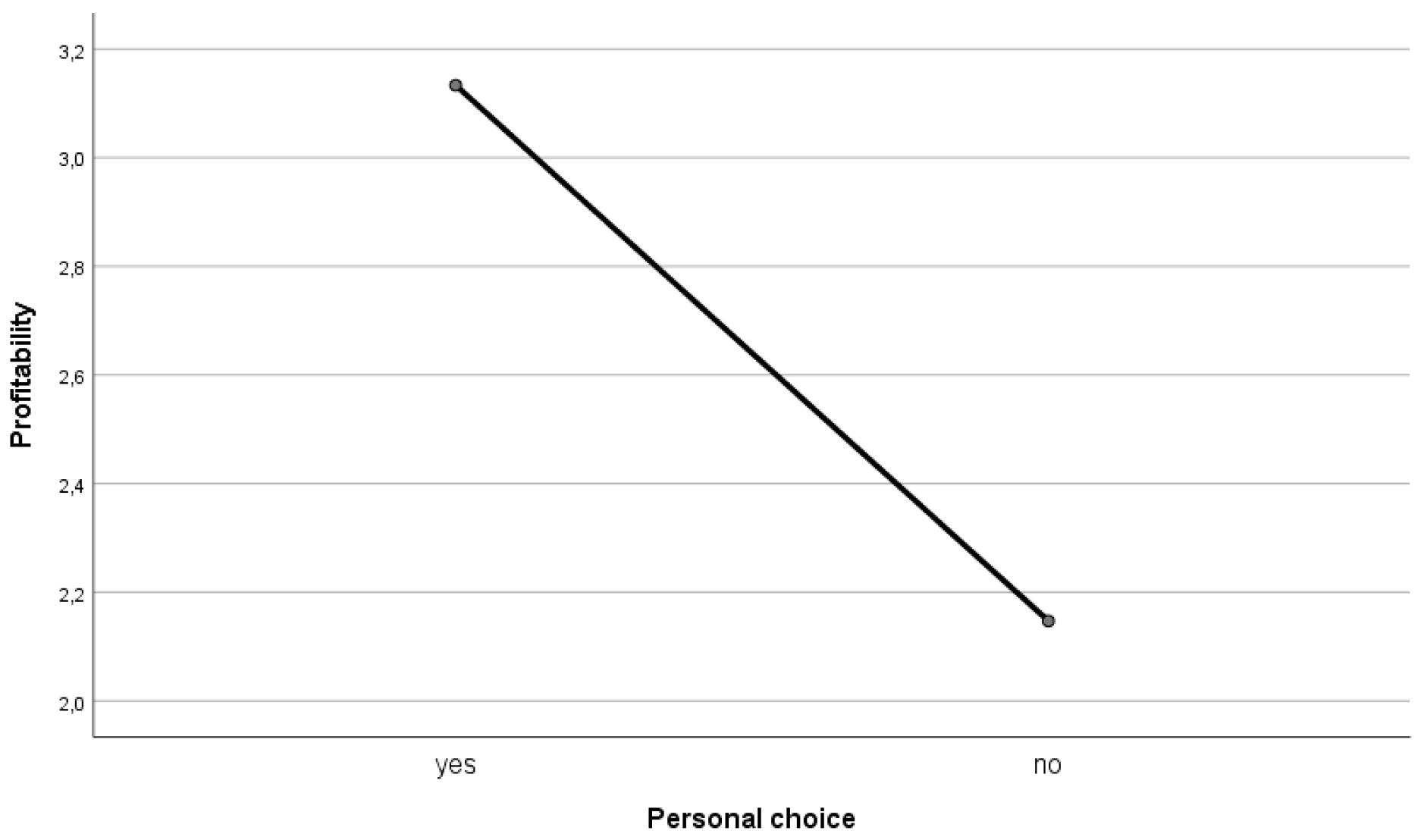
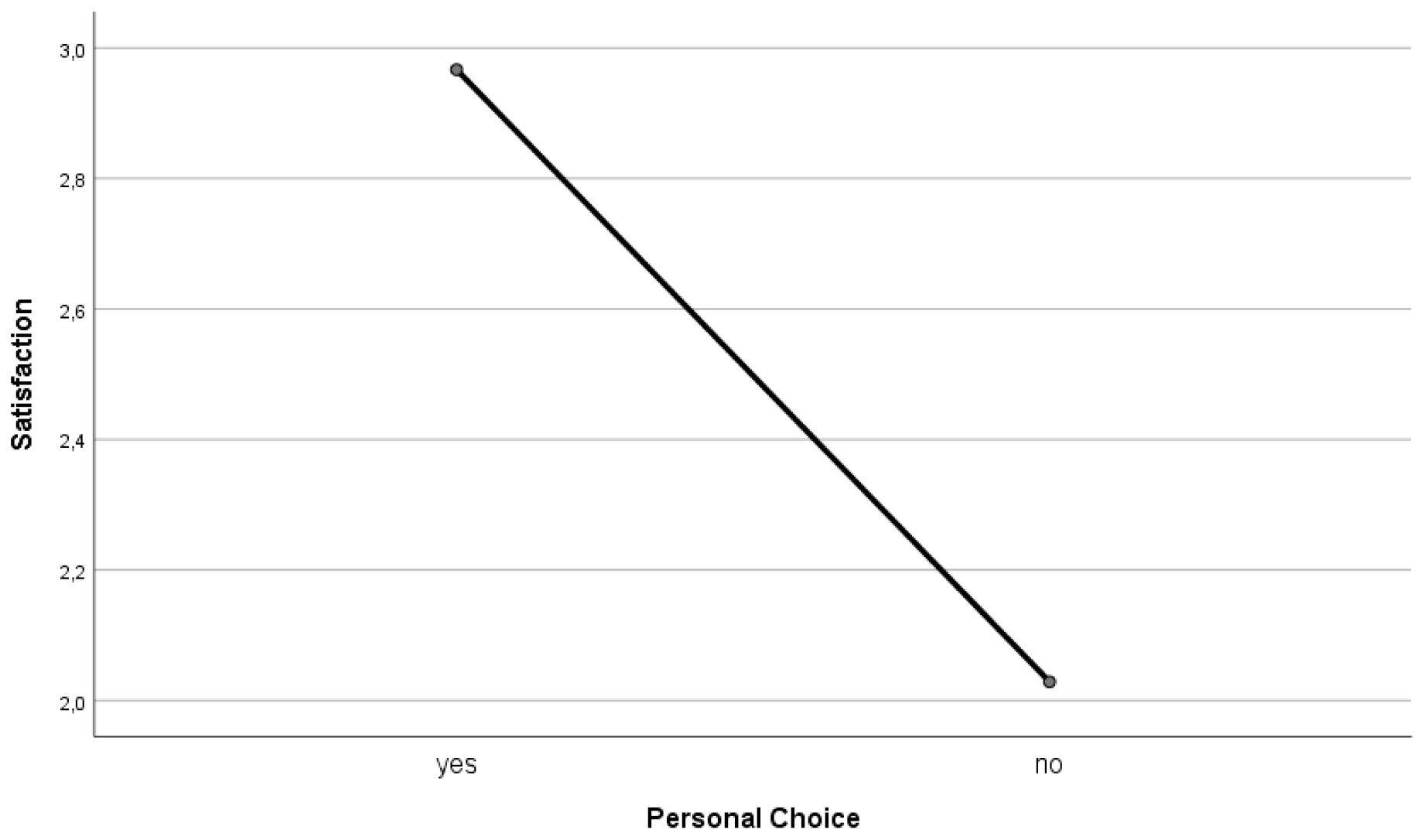
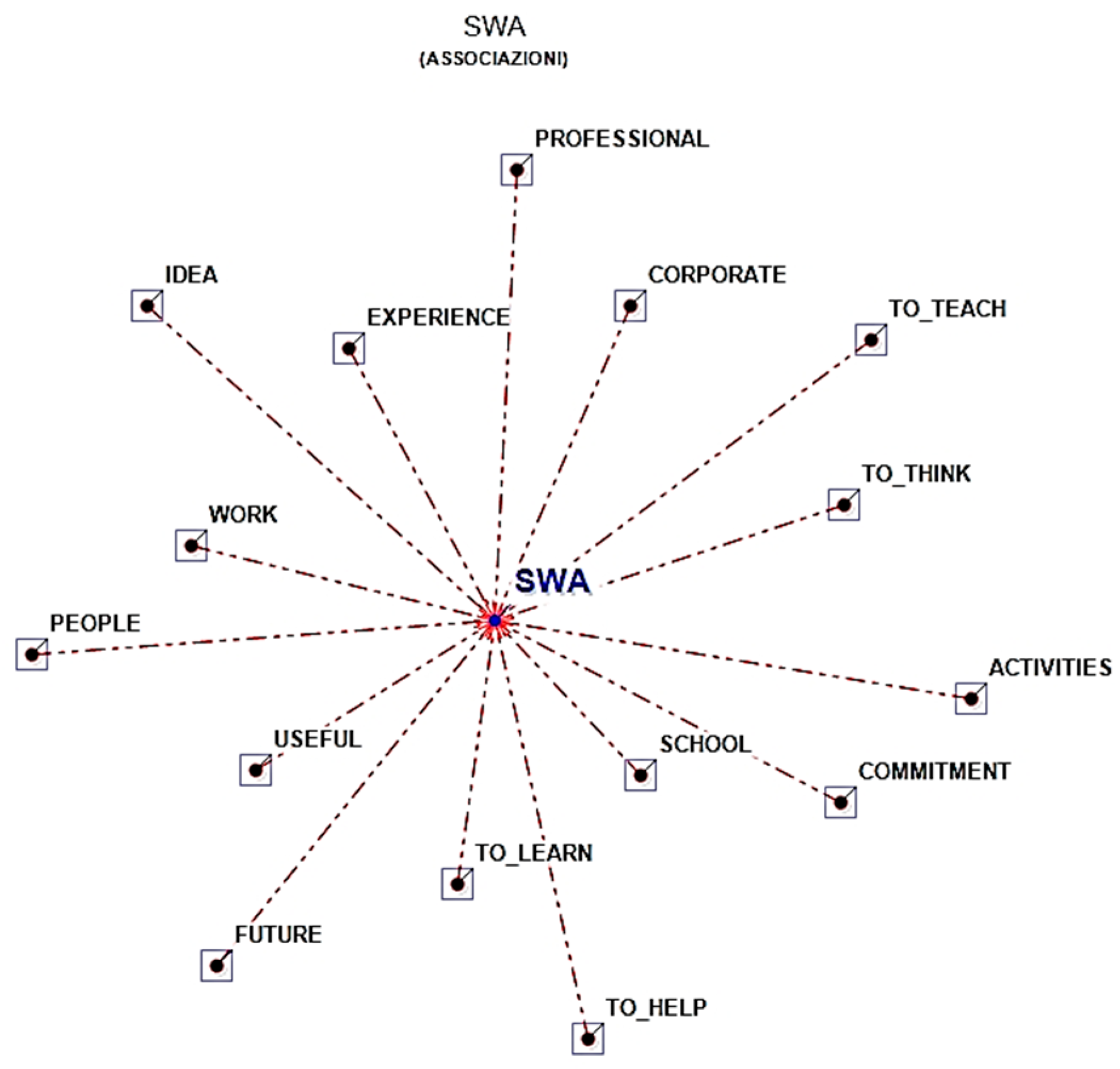
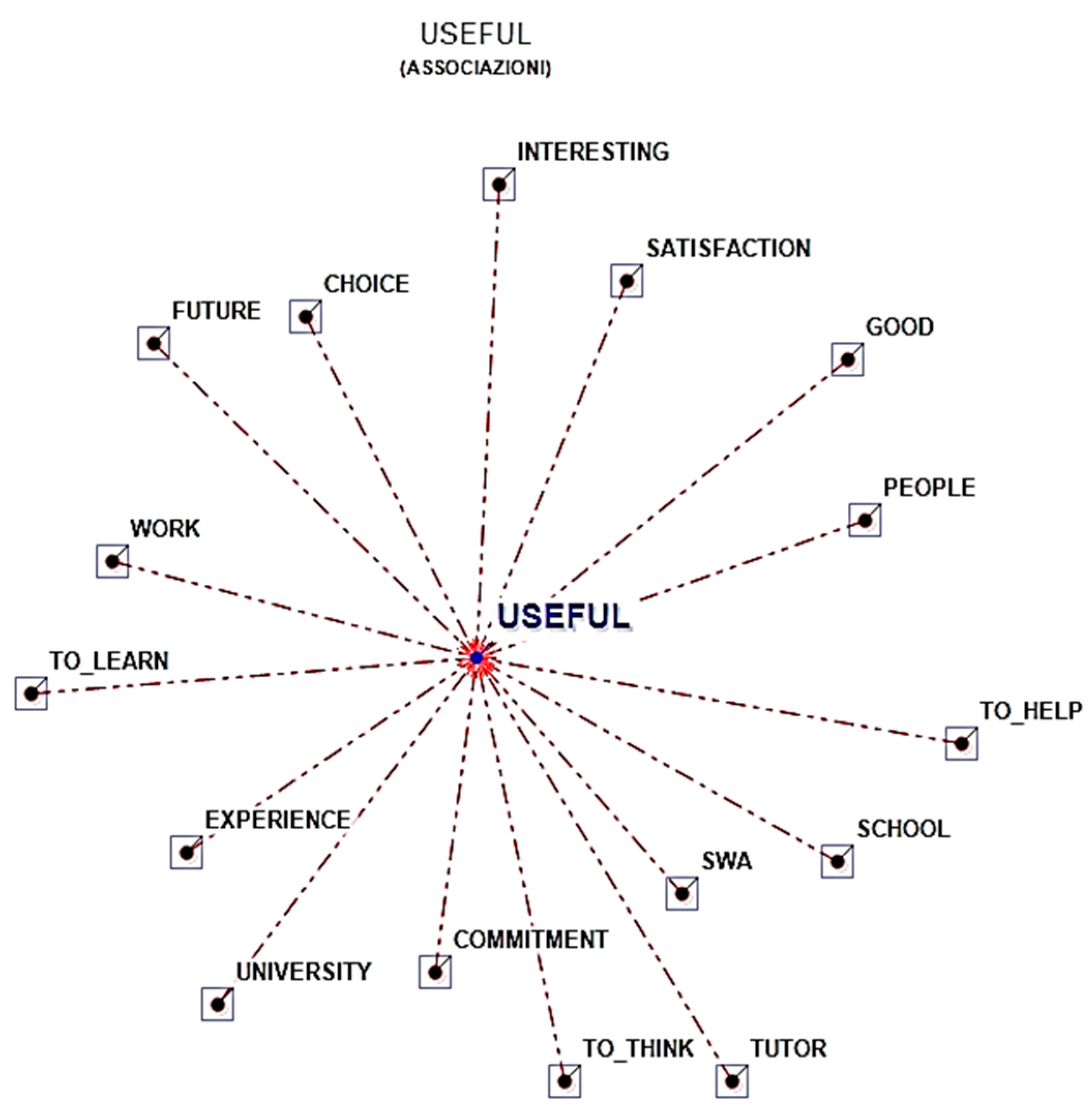
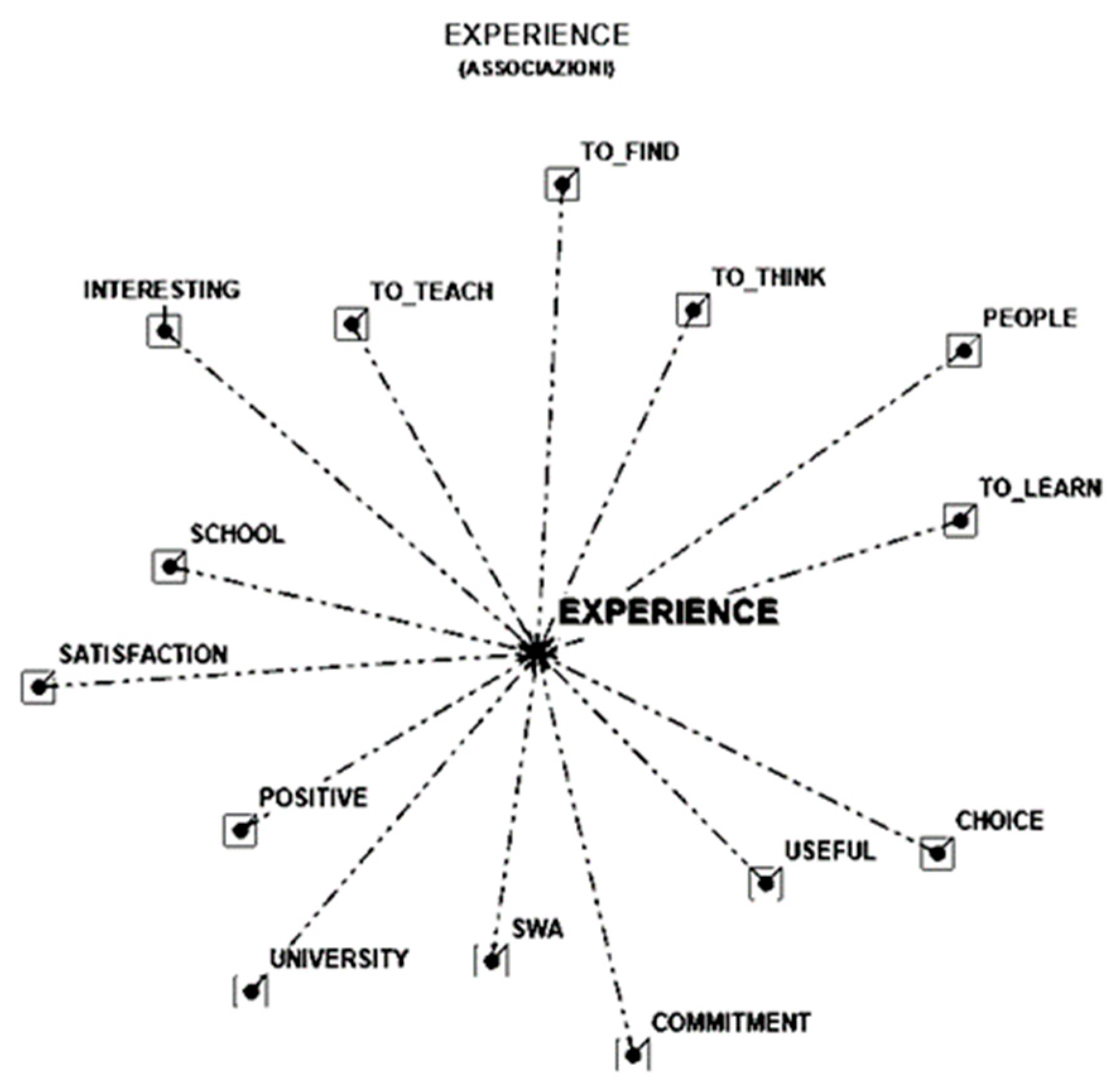
| Variable | Mean | Standard Deviation | Skewness | Kurtosis | Likert Scale Anchors |
|---|---|---|---|---|---|
| Usefulness of SWA | 2.84 | 0.739 | 0.016 | −0.626 | From 1 (very little useful) to 5 (very much useful) |
| Interest in SWA | 2.76 | 0.729 | −0.365 | 0.169 | From 1 (very low interest) to 5 (very high interest) |
| Suitability of SWA environment | 3.21 | 0.881 | −0.306 | 0.005 | From 1 (very low suitability) to 5 (very high suitability) |
| Risk prevention in SWA | 2.72 | 1.06 | −0.065 | −0.661 | From 1 (very low prevention) to 5 (very high prevention) |
| Support in SWA | 3.15 | 0.754 | 0.410 | 0.135 | From 1 (very low support) to 5 (very high support) |
| SWA Tutorship | 3.29 | 0.764 | −0.341 | 0.383 | From 1 (very low availability) to 5 (very high availability) |
| Engagement in SWA | 3.32 | 0.692 | −390 | 0.236 | From 1 (zero engagement) to 5 (total engagement) |
| SWA Satisfaction | 2.86 | 0.737 | -0.255 | −0.074 | From 1 (not at all satisfied) to 5 (completely satisfied) |
| SWA Profitability | 2.60 | 0.896 | 0.336 | −0.211 | From 1 (not at all profitable to 5 (completely profitable) |
| Variables | Categories | Numbers | Percentage | Average | Sd |
|---|---|---|---|---|---|
| 1. Gender | M | 18 | 28.6% | ||
| F | 45 | 71.4% | |||
| Other | |||||
| Total | 63 | 100% | |||
| 2. Age | 16 | 4 | 6.3% | ||
| 17 | 15 | 23.8% | |||
| 18 | 25 | 39.7% | |||
| 19 | 19 | 30.2% | |||
| Total | 63 | 100% | 17.94 | 0.896 | |
| 3. School | High school | 49 | 77.8% | ||
| Technical Institutes | 13 | 20.6% | |||
| Professional Institutes | 1 | 1.6% | |||
| Total | 63 | 100% | 1.23 | 0.465 | |
| 4. SWA partner sector | Tourism | 10 | 15.9% | ||
| Accounting | 4 | 6.3% | |||
| Personal services | 22 | 34.9% | |||
| Catering | 3 | 4.8% | |||
| Education and training | 14 | 22.2% | |||
| Transport | 1 | 1.6% | |||
| Industry | 5 | 7.9% | |||
| Publishing | 2 | 3.2% | |||
| Entertainment | 1 | 1.6% | |||
| Total | 63 | 100% | |||
| 5. Choice | Personal | 12 | 19% | ||
| Familiar | 4 | 6.3% | |||
| Scholastic | 37 | 58.7% | |||
| Casual | 10 | 16.09% | |||
| Total | 63 | 100% | |||
| 6. SWA Satisfaction | Not at all | 8 | 13.8% | 2.86 | 0.74 |
| Slightly | 26 | 40% | |||
| moderately | 21 | 32.3% | |||
| Completely | 8 | 13.8% | |||
| Total | 63 | 100% | |||
| 7. SWA Profitability | Not at all | 1 | 1.5% | 2.60 | 0.90 |
| Slightly | 20 | 30.8% | |||
| moderately | 30 | 47.7% | |||
| Completely | 12 | 18.5% | |||
| Total | 63 | 100% |
| LEMMA_B | COEFF | CE_B | CE_AB | CHI2 | (p) |
|---|---|---|---|---|---|
| School | 0.593 | 25 | 25 | 22.586 | 0 |
| To_learn | 0.462 | 29 | 21 | 3.160 | 0.075 |
| Useful | 0.459 | 56 | 29 | 1.748 | 0.186 |
| Work | 0.421 | 35 | 21 | 0.065 | 0.798 |
| Experience | 0.407 | 34 | 20 | 0.007 | 0.93 |
| Corporate | 0.363 | 18 | 13 | 1.707 | 0.191 |
| To_think | 0.356 | 16 | 12 | 2.137 | 0.144 |
| Commitment | 0.332 | 25 | 14 | 0.062 | 0.803 |
| To_help | 0.287 | 17 | 10 | 0.003 | 0.955 |
| Future | 0.285 | 14 | 9 | 0.241 | 0.623 |
| Professional | 0.274 | 12 | 8 | 0.392 | 0.531 |
| To_teach | 0.274 | 12 | 8 | 0.392 | 0.531 |
| LEMMA_B | COEFF | CE_B | CE_AB | CHI2 | (p) |
|---|---|---|---|---|---|
| Swa | 0.459 | 71 | 29 | 1.748 | 0.186 |
| Commitment | 0.454 | 25 | 17 | 6.183 | 0.013 |
| Experience | 0.412 | 34 | 18 | 0.940 | 0.332 |
| Work | 0.383 | 35 | 17 | 0.140 | 0.,707 |
| Choice | 0.379 | 15 | 11 | 5.182 | 0.023 |
| Satisfaction | 0.356 | 9 | 8 | 7.230 | 0.007 |
| People | 0.349 | 21 | 12 | 1.290 | 0.256 |
| School | 0.347 | 25 | 13 | 0.470 | 0.493 |
| To_think | 0.334 | 16 | 10 | 2.043 | 0.153 |
| University | 0.334 | 16 | 10 | 2.043 | 0.153 |
| To_learn | 0.322 | 29 | 13 | 0.017 | 0.894 |
| Future | 0.321 | 14 | 9 | 2.152 | 0.142 |
| Interesting | 0.306 | 19 | 10 | 0.410 | 0.522 |
| To_help | 0.291 | 17 | 9 | 0.394 | 0.53 |
| LEMMA_B | COEFF | CE_B | CE_AB | CHI2 | (p) |
|---|---|---|---|---|---|
| Useful | 0.412 | 56 | 18 | 0.940 | 0.332 |
| Swa | 0.407 | 71 | 20 | 0.007 | 0.93 |
| Positive | 0.400 | 9 | 7 | 12.040 | 0.001 |
| School | 0.377 | 25 | 11 | 4.070 | 0.044 |
| To_teach | 0.346 | 12 | 7 | 6.144 | 0.013 |
| To_think | 0.342 | 16 | 8 | 4.486 | 0.034 |
| To_learn | 0.318 | 29 | 10 | 0.827 | 0.363 |
| Choice | 0.309 | 15 | 7 | 3.006 | 0.083 |
| Commitment | 0.308 | 25 | 9 | 1.034 | 0.309 |
| University | 0.300 | 16 | 7 | 2.310 | 0.129 |
| Satisfaction | 0.285 | 9 | 5 | 3.705 | 0.054 |
| Interesting | 0.275 | 19 | 7 | 0.901 | 0.342 |
| To_find | 0.271 | 10 | 5 | 2.654 | 0.103 |
| People | 0.261 | 21 | 7 | 0.376 | 0.539 |
Disclaimer/Publisher’s Note: The statements, opinions and data contained in all publications are solely those of the individual author(s) and contributor(s) and not of MDPI and/or the editor(s). MDPI and/or the editor(s) disclaim responsibility for any injury to people or property resulting from any ideas, methods, instructions or products referred to in the content. |
© 2024 by the authors. Licensee MDPI, Basel, Switzerland. This article is an open access article distributed under the terms and conditions of the Creative Commons Attribution (CC BY) license (https://creativecommons.org/licenses/by/4.0/).
Share and Cite
Fantinelli, S.; Cortini, M.; Di Fiore, T.; Iervese, S.; Galanti, T. Bridging the Gap between Theoretical Learning and Practical Application: A Qualitative Study in the Italian Educational Context. Educ. Sci. 2024, 14, 198. https://doi.org/10.3390/educsci14020198
Fantinelli S, Cortini M, Di Fiore T, Iervese S, Galanti T. Bridging the Gap between Theoretical Learning and Practical Application: A Qualitative Study in the Italian Educational Context. Education Sciences. 2024; 14(2):198. https://doi.org/10.3390/educsci14020198
Chicago/Turabian StyleFantinelli, Stefania, Michela Cortini, Teresa Di Fiore, Stefano Iervese, and Teresa Galanti. 2024. "Bridging the Gap between Theoretical Learning and Practical Application: A Qualitative Study in the Italian Educational Context" Education Sciences 14, no. 2: 198. https://doi.org/10.3390/educsci14020198
APA StyleFantinelli, S., Cortini, M., Di Fiore, T., Iervese, S., & Galanti, T. (2024). Bridging the Gap between Theoretical Learning and Practical Application: A Qualitative Study in the Italian Educational Context. Education Sciences, 14(2), 198. https://doi.org/10.3390/educsci14020198






